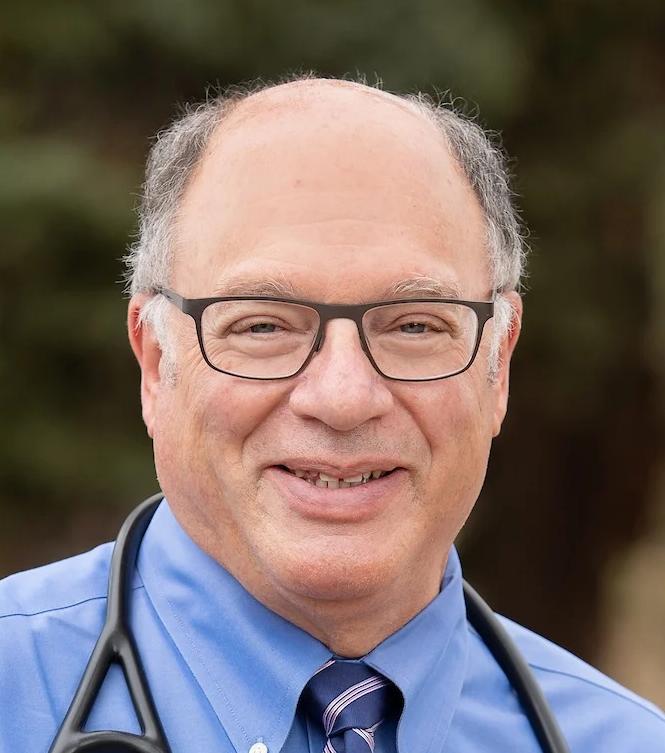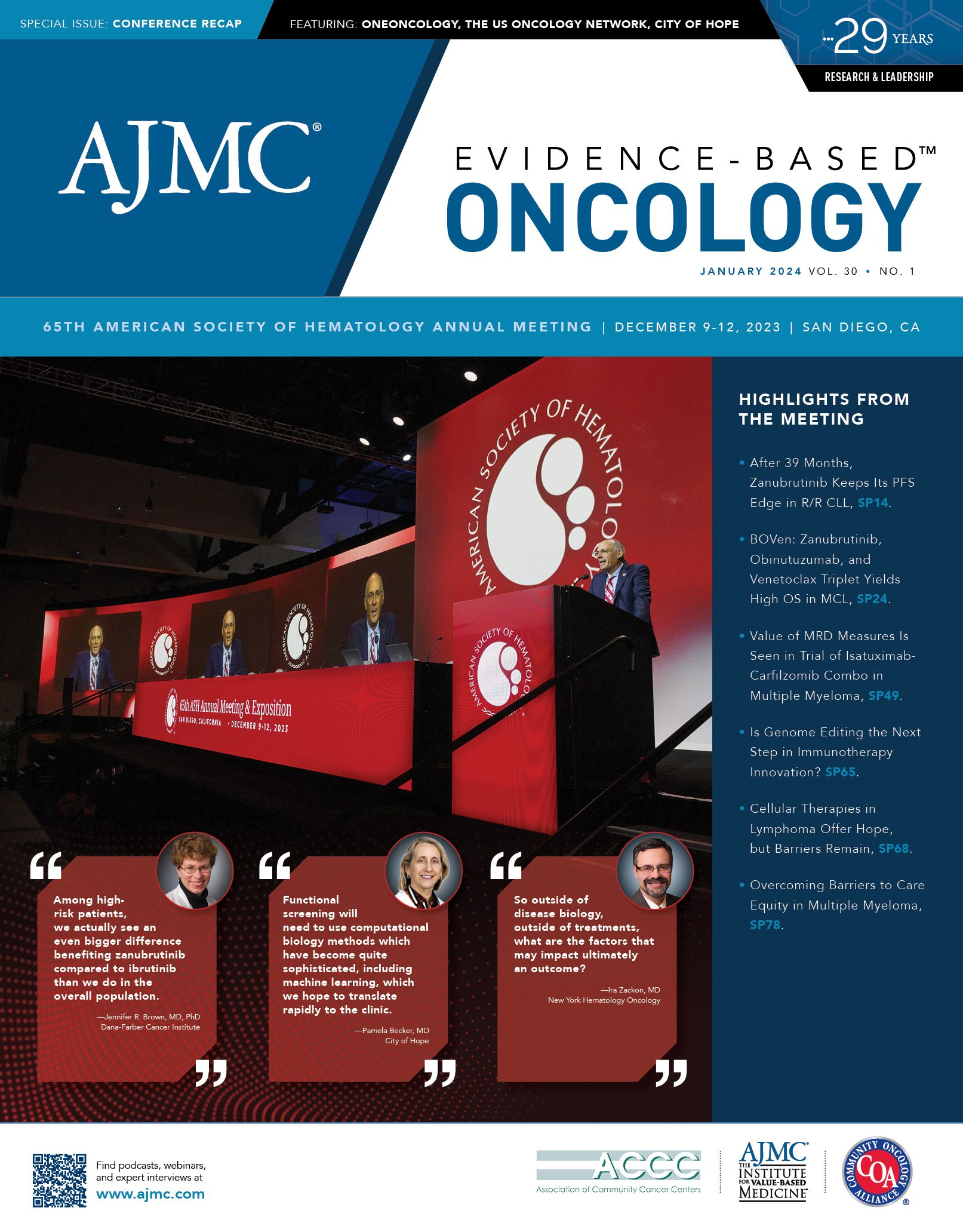- Center on Health Equity & Access
- Clinical
- Health Care Cost
- Health Care Delivery
- Insurance
- Policy
- Technology
- Value-Based Care
Preventing Adverse Events With Bispecific Antibodies in Myeloma in the Community Setting
Robert Rifkin, MD, medical oncologist and hematologist at Rocky Mountain Cancer Centers, shares insight into how the phase 2 Optec study of teclistamab administration in the outpatient setting could help achieve important health equity and quality goals.
During the 65th American Society of Hematology Annual Meeting and Exposition, Robert Rifkin, MD, medical oncologist and hematologist at Rocky Mountain Cancer Centers, made a presentation on Optec, a phase 2 study that just opened enrollment (NCT05972135).1
Robert Rifkin, MD | Image: The US Oncology Network

Optec will evaluate outpatient administration of teclistamab, a B-cell maturation antigen–targeting bispecific antibody in patients with multiple myeloma. A key strategy will be the prophylactic use of tocilizumab.
Rifkin answered questions from Evidence-Based Oncology (EBO) about the study and how it will help achieve important health equity and quality goals.
EBO: Your study, which has just started enrollment, will give patients with multiple myeloma prophylactic doses of tocilizumab prior to treatment with teclistamab in the outpatient setting. Can you discuss the rationale for this approach?
Rifkin: The rationale for this approach is fairly straightforward. As we have developed new classes of drugs in multiple myeloma, they initially appear in later lines of therapy and are gradually brought to earlier lines of therapy. As comfort with the administration of a new agent grows, we then try to make administration more convenient and safer. By following the original FDA label,2 the incidence of complications with a new agent is spelled out. In this case, the unique toxicities are cytokine release syndrome (CRS) and [immune effector cell-associated neurotoxicity syndrome] ICANS.
Patients start the study after 4 lines of therapy. As is the case with the bispecific antibodies, the immediate complications are CRS and ICANS, which is a neurologic complication. It is our expectation, based on preliminary data from other studies, to generate data showing that we can give the treatment for cytokine release in a preemptive fashion.
The patients on our study will be pretreated with tocilizumab and corticosteroids prior to receiving their first dose of teclistamab. It is already known from the MajesTEC-1 trial3 (NCT03145181 and NCT04557098) and others that this approach should significantly decrease the incidence and severity of cytokine release syndrome.
EBO: What barriers to treatment do patients with multiple myeloma face in receiving teclistamab if it cannot be administered in an outpatient setting?
Rifkin: I think what everybody has to keep in mind is this is a heavily pretreated myeloma population, and they are often elderly and frail. The concept is to make it easier for them and to avoid the hospital admission process for each step-up dose. It is well understood that by the time you’ve completed a couple of weeks of therapy, a couple of cycles, the incidence of CRS [cytokine release syndrome] and ICANS [immune effector cell-associated neurotoxicity syndrome] goes down rapidly and does not recur. That should make it much easier for patients if we can start them in the outpatient setting, get those key step-up doses and the first full dose in. By then they’re usually already responding and feeling better. Ideally, we can then return them back to the referring.
EBO: In 10 years, it is estimated that a quarter of all patients with multiple myeloma will be African American. Are these patients able to access teclistamab at levels on par with the rate of the disease burden in the population? Will community access change this situation?
Rifkin: This is a hot topic permeating all of health care with a focus on all of research. For every trial that we conduct, we’re required to include diversity, equity, and inclusion data. We recently published the results of our effort at DEI in JNCCN [Journal of the National Comprehensive Cancer Network].4 In short, we need to place the drugs where the need is the greatest. What we always tell people coming through our research program is if you give it on a clinical trial, then you’re comfortable with it and you can remember how to spell it and use it when it gets FDA approved, and target the correct population of patients.
Toward that end, I think we will improve access in the community. I’m part of a very large network that has areas where we certainly need to improve access, but I think that will come. Myeloma is different in African Americans, probably more aggressive, but if you cast that aside, the biggest issue is the delay to access and getting treated, and it almost doesn’t matter with what drug.
To that point, we really have to work hard doing outreach, both traditional and nontraditional, to capture those folks in trials.
EBO: The settings selected thus far for this trial are in Virginia, Oregon, and Colorado. Do you anticipate enrolling diverse groups of patients from these sites? Do you anticipate adding any sites?
Rifkin: The first few sites are opened in order for us to carry out PK/PD [pharmacokinetic/pharmacodynamic] requirements by the FDA regulators. We will then be adding sites—to a total of 12 sites all around the country and hopefully with diverse patient populations.
EBO: Is there an estimated cost savings for administering teclistamab in an outpatient setting?
Rifkin: We haven’t really done that analysis yet, but we plan to look into it as we accumulate the data. This will be one of our goals because per the Enhancing Oncology Model [EOM], we need to hold down costs and doing this in the outpatient setting will be a very good way to do it.5 We’ll then use our data to do modeling prospectively.
EBO: Will you be using any digital tools to collect electronic patient-reported outcomes, or ePROs, during this trial?
Rifkin: This is a favorite question of mine; ePROs are patient-reported outcomes and while we’re not quite there yet, those are in the offing and certainly everybody wants to do that, because if you can use that and remote patient monitoring, then you’ll be able to detect CRS and hopefully ICANS earlier to treat them aggressively and prevent hospitalizations and conserve resources. In the EOM model, myeloma is one of the 7 diseases targeted, and it’s the most expensive, so that’s on everybody’s mind.
References
1. Rifkin R, Sharman JP, Fowler J, et al. Optec: a phase 2 study to evaluate outpatient administration of teclistamab, a BCMA-targeting bispecific antibody, in patients with multiple myeloma. Presented at: 65th American Society of Hematology Annual Meeting and Exposition; December 9-12, 2023; San Diego, CA. Abstract 3374. https://ash.confex.com/ash/2023/webprogram/Paper185257.html
2. Step-up dosing schedule. Tecvayli. Accessed December 13, 2023. https://bit.ly/3uYEV16
3. Moreau P, Garfall AL, van de Donk NWC, et al. Teclistamab in relapsed or refractory multiple myeloma. N Engl J Med. 2022;387(6):495-505. doi:10.1056/NEJMoa2203478
4. Richter J, Noga SJ, Rifkin R. Ensuring diversity and inclusion in clinical development by leveraging community oncology centers. J Natl Compr Canc Netw. 2023;21(8):889-891. doi:10.6004/jnccn.2023.7058
Enhancing Oncology Model. Center for Medicare & Medicaid Services. June 27, 2023. Accessed December 13, 2023. https://www.cms.gov/priorities/innovation/innovation-models/enhancing-oncology-model

The Importance of Examining and Preventing Atrial Fibrillation
August 29th 2023At this year’s American Society for Preventive Cardiology Congress on CVD Prevention, Emelia J. Benjamin, MD, ScM, delivered the Honorary Fellow Award Lecture, “The Imperative to Focus on the Prevention of Atrial Fibrillation,” as the recipient of this year’s Honorary Fellow of the American Society for Preventive Cardiology award.
Listen
From MSSP ACOs to Employer Value: Translating Value-Based Principles to Self-Insured Plans
December 12th 2025Value-based care adoption in employer insurance requires replacing fragmented point solutions with unified, at-risk performance contracts that align vendors, providers, and members around total cost and quality goals.
Read More
Legal Issues in Value-Based Care Contracts for Self-Insured Employers
December 12th 2025Self-insured employers face regulatory challenges when adopting value-based contracts, requiring careful data governance, standardized metrics, and legal frameworks to align with federal value-based care models.
Read More
